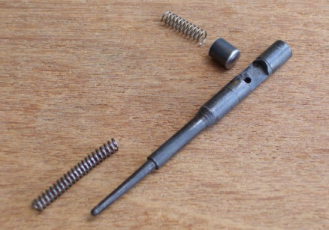
Gunsmith Horror Stories
Gunsmith Horror Stories
Anyone can make a mistake.
But when a self-proclaimed "gunsmith" makes a mistake,
it can be spectacular!
A friend of mine works part-time as a gunsmith.
A real gunsmith, mind you, someone who really
knows what he's doing with machine shop work in general
and firearms work in particular.
I am a little uncomfortable using the term "gunsmithing"
on my pages, as I've just done things like help a friend
with projects to
parkerize
parts (in which we haven't burned down his house yet)
and to do the
finish reaming on some Garand replacement barrels
(in which we haven't ruined any barrels yet).
But at least I have the sense to be careful and worry
that I shouldn't describe anything I do as "gunsmithing".
Unlike some people I've heard about.
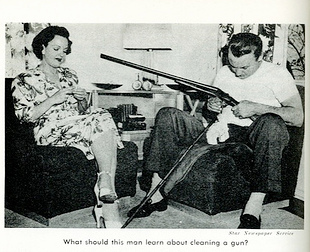
The following examples come from telephone calls in which customers have had some rather surprising questions. It's good to ask questions. When you work with precision devices, you should be precise. And when those devices are potentially dangerous, you should be especially careful. But these stories are ones in which the caller started by describing themself as an experienced gunsmith, but then asked a surprising question or told a startling story suggesting casual use of that term.
Background
The Czech ČZ-52 is a pretty popular surplus pistol. However, its firing pin design has a number of problems.
Beyond the fact that the ČZ-52 pretty much has no functional safety once it's been fired enough times to cause the least bit of internal wear, and the danger that its "decocker" lever is often just an alternative method of firing, its original firing pin will break if you dry-fire it just a few times. Or maybe just once.
See these pictures of three firing pins. One of the three pins is a rare item, an original non-broken ČZ-52 firing pin. The other two are broken.
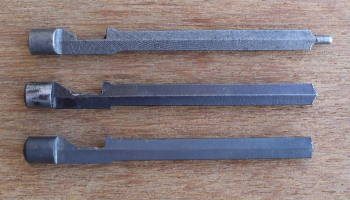
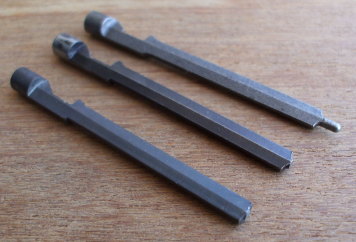
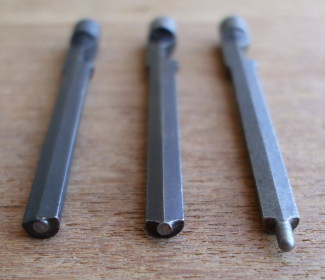
The design calls for the firing pin to be struck by the hammer and fly forward until the nose of the pin strikes the cartridge primer through a small hole in the rear face of the slide. The firing pin is then returned to its normal position by a spring backed plunger riding against that 45° cutout near its rear.
Dry-firing (that is, "firing" the weapon without a round in the chamber, so as to familiarize yourself or practice with it) causes the "shoulder" of the firing pin around the nose to strike the forward end of the cylindrical chamber in the slide in which the pin rides. That abruptly stops the pin with its nose protruding a little further than usual into the actual chamber.
The original ČZ-52 firing pin was made from poor steel which very quickly work-hardens and becomes brittle. After a very few such blows, maybe even on the first one, that small nose breaks off and renders the weapon unable to fire.
There are a few small firms machining replacement firing pins, but they use this same design and, according to reports, similarly brittle steel. You could replace your broken pin with one of these, but you would quickly have the same problem with that replacement.
So this friend of mine developed a replacement firing pin, one that was slightly modified. His design has a much longer and tapered nose, and he has added a return spring. See harringtonproducts.com for details on these replacements and other ČZ-52 parts.
The return spring absorbs the shock of dry-firing, protecting against work hardening. The pin's forward motion is stopped by the compression of this added return spring, not by striking against that internal face within the slide.
In addition, he is careful to only use quality steel. Yes, you have to pay about twice as much for good raw material. But the cheaper steel comes from foundries where they're throwing entire junk cars into the furnace — glass, upholstery, dashboard, and all.
He used to have an agreement with a guy who ran a gun shop somewhere in Virginia. One of that shop's web pages mentioned these replacement firing pins. It was a poorly constructed page within a poorly designed web site, and every once in a while he would get an order.
He asked me about web site design. We set up an entire web site for his replacement parts, and the orders started pouring in!
And every once in a while, usually late at night, he gets a telephone call from a confused or frightened or angry customer, starting with the fateful phrase "You see, I've been a gunsmith for twenty-odd years now, and ...."
Gunsmith Horror Story #1
Springs is springs, right?
Another design of his replaces the angled return plunger with a cylindrical one providing more positive firing pin retention. Here you see the firing pin, its return spring on its long tapered nose, and the cylindrical plunger and its spring.
One of these "experienced gunsmiths" called one evening, all huffy because his new firing pin didn't work quite right. It was the competition design seen here.
Oh, it fired the pistol. Usually. Well, sometimes. It was erratic, you see. Oh, and by the way, the firing pin tends to fly out the back of the slide and hit you in the face when the pistol is fired.
Careful inquiries brought hurried assurances that yes, he had followed all the installation instructions to the letter.
Yes, of course his firing pin had been correctly installed. All the other parts were in place. Well, there had been an issue with the first plunger spring, but....
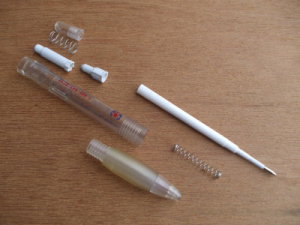
Not really an appropriate source of gun repair parts.
Wait, the first spring? What's that about?
The thing about springs is that they're, well, springy. If you compress them, they're liable to fly off and land who knows where in all the clutter and shag carpeting and such.
This guy had lost his plunger spring, and being the experienced gunsmith that he was, figured that any spring would work so long as it could be made to fit.
So he disassembled a handy ballpoint pen and tried using its spring. It was too long, so he cut off some of the turns.
Yes, it fit into the cup of the plunger, and the plunger and the firing pen, er, I mean pin, slipped into place in the slide, and everything reassembled.
But the resulting assembly did not function properly.
The ballpoint pen spring was not strong enough to keep the plunger in place. These internal components are shaken very strongly when the slide cycles during firing. Sometimes that includes the plunger being shaken upwards far enough to completely clear that pocket in the firing pin, allowing the firing pin to fly backwards and leave the slide.
Gunsmith Horror Story #2 (and 4, and 5, and counting)
I really think I should have to pull the trigger!
This is the scariest one....
The ČZ-52 is a surplus firearm, and so it will come packed with Cosmoline. Or with whatever the Czech word for Cosmoline might be. A very real danger is that the cylindrical chamber for the firing pin within the slide might still have some residual thick grease deposits. When the tip of the firing pin breaks off, there's a chance that it could become lodged in that grease back within the slide. When you install one of these redesigned firing pins, that little chunk of metal might become jammed between the spring and the wall of that chamber, holding the pin rigidly in place.
Here you see the slide of a ČZ-52, laid upside down. We're looking toward the bolt face, the face of the slide from which the firing pin protrudes when the gun is fired.
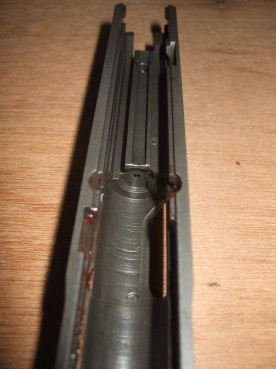
The first picture below is just a detail of that last picture above. We can easily see that vertical face that functions like the bolt face in a rifle. In fact, the proper term for this surface within the slide is the "bolt face".
See the hole in the center of the bolt face. The firing pin will emerge from here to strike the cartridge primer. If you look closely, you can just see the tip of the firing pin back in that hole.
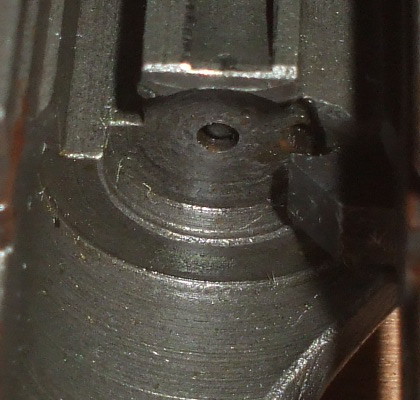
This is what you should expect to see.
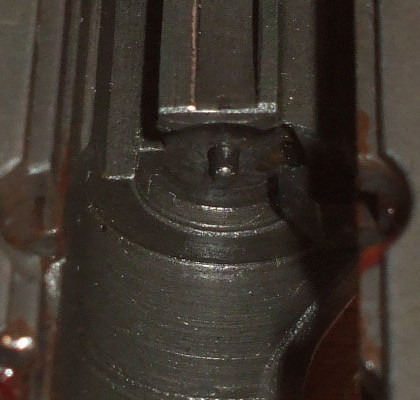
This is extremely dangerous, the gun will repeatedly fire when the slide is released!
If you inserted a replacement firing pin when the pin's chamber within the slide contained grease deposits, and the old firing pin nose fragment was embedded in that grease, then the new firing pin might be firmly lodged protruding from the slide face.
See the second picture above: The nose of the firing pin is protruding from the bolt face.
This is an extremely dangerous condition. If the slide were dropped closed on a chambered round in the normal fashion, the gun would spontaneously fire. As this is a semi-automatic or self-loading weapon, the gun would continue to cycle until the magazine was empty.
Bold-faced yellow highlighted text and pictures like these are included in the detailed description of how to install these replacement parts. People are clearly told to look for this problem and warned of its danger.
Would someone who described himself as a gunsmith with decades of experience assemble a gun with a rigidly protruding firing pin, load the weapon, drop the slide, and then be surprised when it fires as soon as the slide slams shut?
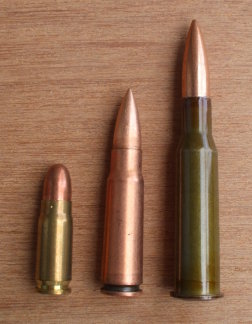
Left: 7.62x25mm Tokarev
Center: 7.62x39mm
Right: 7.62x54R
Sometimes.
I have heard of three cases of this so far.
One guy drilled a 7.62mm hole through his nice hardwood floor.
That just made one hole. Another one of these "experienced gunsmiths" loaded a full magazine and let the slide slam closed. At least he was at an outdoor range, had the pistol pointing in a reasonably safe direction (well, for the first two or three rounds), and no bullets caused damage when they returned to the ground. The 7.62x25mm Tokarev round is more or less a small rifle rifle round, and the ČZ-52 pistol's muzzle climbs rapidly when it has been mangled into an uncontrolled fully automatic configuration.
Think about this. These reports have to be just the tip of the iceberg.
Some people who set up a slam-fire like this are going to realize what happened, either immediately or upon investigation. They will be embarrassed and consider it a frightening lesson learned (perhaps at the expense of some property damage, hopefully no injury or worse).
Others will be frightened, lock the pistol away in a box, and never touch it again.
So, these phone calls are from people who have incorrectly assembled the pistol, were startled when it slam-fired, but still did not know what was going on and called demanding an explanation. These slam fires must happen more often than we hear about.
Gunsmith Horror Story #3
I'm not just a gunsmith, I'm a big-time armorer!
Then there was the guy who said he was an armorer for the Los Angeles Police Department.
His problem?
He couldn't figure out how to get the original firing pin out of the slide.
Again, this is despite detailed step by step instructions with illustrations on the web site.



